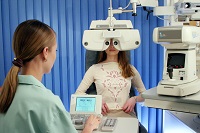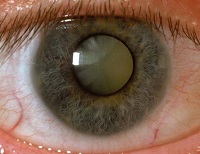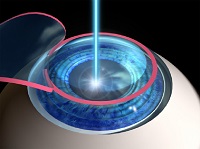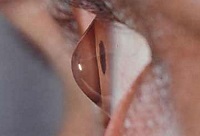Our goal is to restore your vision!
First time at the base private clinic in Russian ophthalmological practice, in 1996, Professor Kurenkov V.V. and his colleagues introduced and began performing vision correction operations using a new generation excimer laser. From that moment on, the era of excimer laser eye surgery began in Russia. At that time it was the first eye clinic where tens of thousands of refractive surgeries were performed and enormous experience in the domestic practice of laser vision correction was accumulated!
We currently use the most modern and reliable technologies to correct refractive errors such as myopia, farsightedness and astigmatism!
In our practice, we use vision restoration techniques such as LASIK, PRK, EpiLASIK and, of course, our patented unique REIC technology.
We have been restoring vision since 1996!
All excimer laser surgery techniques are aimed at changing the geometric parameters of the cornea, whereby the optical system of the human eye no longer needs aids corrections such as glasses or contact lenses!
Important to know! The operation is performed on the cornea of the eye and changes its refractive power, which makes it possible to focus the image in the macular area on the retina and, thereby, ensure high visual acuity.
Refraction is the refractive power optical system eyes, expressed in diopters.
Refractive errors are a common pathology that leads to a decrease in quality of life.
Myopia, farsightedness and astigmatism always manifest as decreased vision. With all refractive errors, the eye cannot focus at the required distance, so it is necessary to correct vision with glasses or contact lenses, which, you see, is not always convenient, and sometimes unsafe.
Of all refractive errors, myopia is the most common - according to statistics, every third person on the planet suffers from myopia! It can be detected at any age, but typically occurs between 8 and 16 years of age and then either progresses or stabilizes. But in any case, myopia reduces the quality of life and requires constant attention.
Important to know! With reduced vision, correction is always necessary! The common myth that using glasses and contacts reduces vision is indeed a myth. If you don't use it correct correction– the eyes lose the habit of working, which leads to amblyopia, better known as lazy eye. When this pathology develops, the eyes, even with adequate correction, are no longer able to see 100%.
Our clinic uses advanced methods for diagnosing and treating refractive errors of the eye. Excimer laser correction will help restore and improve visual acuity.
The widespread prevalence of diseases such as myopia, farsightedness, and astigmatism is a prerequisite for the development of new effective methods correction of refractive errors. One of these is laser vision restoration.

It would seem that glasses and contact lenses exist, they are accessible to everyone and easy to use. But at the same time, thousands of people all over the world undergo laser vision correction every day. Why is this happening? The answer is simple! Every person who uses glasses is very familiar with the feeling of discomfort when using them for a long time; pressure inevitably occurs on the bridge of the nose and ears, it can even cause pain! And what happens in winter - when the temperature in the surrounding space changes, the glasses fog up, which, you see, is very inconvenient. In addition, glasses are extremely inconvenient for sports and outdoor activities. What if you forget or lose your glasses? The day is lost. As for contact lenses, of course, correctly selected lenses are much more comfortable than glasses, since the lens is located directly on the surface of the eye and creates a single optical system with it. The lenses do not fog up like glasses, do not put pressure on the nose and ears, and are extremely comfortable when playing sports. But, no matter what modern lenses are, their use reduces the access of oxygen to the tissues of the eye, as a result of which blood vessels begin to grow into the cornea, and dry eye syndrome inevitably occurs. That is, the period of use of contact lenses is limited. As a rule, this is 5-10 years, after which changes in the cornea occur, making it difficult to wear lenses.
Laser correction vision provides a new quality of life without glasses and contact lenses! You gain freedom and no longer use glasses or contact lenses!
It is important to understand! At a certain age, usually up to 18 years, glasses and contact lenses are the only by possible means vision correction, as growth continues, including the eye, which is why laser vision correction is not performed. But it is extremely important to follow the contact lens wearing regime, as well as to monitor the dynamics of vision changes with an ophthalmologist and promptly change the diopter of contact and spectacle lenses.
To perform the operation, you must undergo a complete ophthalmological examination. This is necessary to assess the condition of all eye structures and a number of other parameters. Among the main studies, the following can be highlighted:
Pneumotonometry (measurement of intraocular pressure);
Pachymetry (measurement of corneal thickness);
Schirmer test (assessment of tear production);
Echobiometry A-method (measurement of eye length - EZO);
Perimetry (study of visual fields);
Computer topographic analysis of the cornea;
Examination of the fundus in conditions of mydriasis (with a wide pupil);
A full examination allows you to predict the outcome of the operation and avoid possible complications.
The procedure consists of a minimally invasive surgical procedure, during which the curvature of the cornea changes.
Changing the curvature of the cornea using an excimer laser allows you to achieve normal focusing of the image on the retina. The technologies used are a guarantee of safety, accuracy of the procedure and provide the highest possible visual acuity!

The operation itself to restore vision lasts on average 10-15 minutes. Local anesthesia is used - special drops, which eliminates painful and unpleasant sensations! After the operation, you need to stay in the clinic for about an hour and a half under the supervision of specialists, after which you can go home, following our recommendations! Laser vision correction globally does not affect the usual rhythm of life!
Important! After a complete preoperative examination, the ophthalmologist will explain to you in detail the features of pre- and postoperative period, this is very valuable information, which is presented in a special memo for your convenience!
Laser vision correction is one of the most popular operations all over the world!
Advantages of the method:
The effect lasts for life!
It is important to understand! Laser vision correction does not guarantee the absence of other eye diseases in the future!
There are sometimes obstacles to performing eye surgery. In principle, they can be divided into temporary and permanent. What does it mean? Temporary contraindications are reversible conditions both from the eyes and from the body as a whole. After their permission, the operation becomes possible and safe. Here are the main ones:
Constant contraindications for laser correction:
It is important to understand! If there are constant contraindications to excimer laser correction, our specialists will offer alternative and modern methods restoration of vision!
Laser vision correction operations exist in several modifications: Lasik, Reik, Super-Lasik, femto-Lasik, Smile. The names do not reflect the essence, but these are already established terms that are used in modern ophthalmology. The difference between standard Lasik and Reik operations and Super-Lasik is the second stage of correction - the effect of an excimer laser on the cornea. The term Super-Lasik is not entirely correct; non-specialists may think that the technology of standard Lasik is flawed, and Super-Lasik is too excellent. IN English The more correct term custom Lasik is used. It is more correct to call this type of operation personalized Lasik. This does not mean that the standard option is worse, but there are rare cases when the personalized one is more preferable. Each specific case is considered individually and, based on research data, a conclusion is made about the preferred type of operation.
The fundamental difference between the femto-Lasik operation is that the valve is created using a femtosecond microkeratome, and not a mechanical one as with standard Lasik. There is still no clear opinion among experts regarding the femtosecond laser. Some consider it the best tool, while others, on the contrary, prefer the time-tested mechanical microkeratome. So, at present, there is debate about femtosecond Lasik and there is no certainty on this issue yet.
Currently there is new technology performing laser vision correction - Smail. The entire operation is performed only with a femtosecond laser; during operation there is no stage of valve (flap) formation. In the thickness of the cornea, the stage of formation of a refractive section immediately occurs - the lenticule, which is removed special tool through a 2 to 4 mm wide incision formed with a femtosecond laser.
Important to remember! The eyes and your vision are the main means of interaction with the outside world and the main tool in any activity! You need them 365 days a year, 7 days a week and 24 hours a day.
We guarantee accurate diagnosis and individual selection of the optimal vision correction method!
More detailed information You can see the cost of this service in the section
Laser assisted keratomileusis, or LASIK, is popular surgical method treatments used to correct vision in people who are nearsighted, farsighted, or have astigmatism.
Vision is restored within 2 hours after surgery, and the very next day you will be able to lead your usual lifestyle with minor restrictions. Full recovery vision will take you 1 month. For the first three days, you will have to put drops into your eyes every 2 hours. Then you will need to put drops into your eyes 3 times per month. Unpleasant sensations may persist for 10 days after surgery.
The techniques used in laser correction have not been fully tested
The first laser correction was carried out in 1985, more than 28 years have passed since then, during which time all the methods used were well studied, which made it possible to discover and improve new methods that are successfully used in all countries of the world.
Laser is dangerous to the eye
To begin with, it is worth noting that the laser itself is harmless to human eye, during the operation you will not see or feel it. All you will see is a red dot, which you will be asked to concentrate on. The laser takes into account all the individual features of the patient’s eye structure. This is a highly sensitive laser; if you suddenly look away, it will instantly stop working and continue only after you return your eye to its original position.
It is unknown what the result will be
What the result will be after laser correction will be known after the procedure. full diagnostics of your vision, which is carried out in the preoperative period.
Complications often occur after laser correction
Any operation has a certain percentage of complications; it is impossible to completely exclude them. The incidence of complications after laser correction is less than 1%. Most often, as a rule, those who do not follow the recommendations of specialists before and after surgery fall into it.
If you have anything to add, be sure to leave a comment.
Advantages: the world becomes brighter, the results are almost immediate
Disadvantages: expensive, burning in the eyes after surgery, prohibition of visual stress after surgery, prohibition of physical activity for a while, pain in the eyes after surgery, severe tearing
My vision was -6 in both eyes (high myopia) and slight astigmatism (it began to deteriorate in school). Tired of wearing contacts and glasses. An opportunity arose and I decided to have surgery. Moreover, two of my relatives have already undergone such an operation. I walked and, in principle, was not afraid.
I was thinking about where to get laser vision correction using the Lasik method and was comparing prices. I came to the conclusion that I had it done at the Medi clinic on Nevsky, 82. It’s not far, and the clinic has existed for 12 years at the moment.
The price without the discount for their 11th anniversary was more expensive than Excimer, but with a discount(at that time minus 11 thousand, i.e. 5500 from one eye and 5500 from the second) it turned out even cheaper for me than in another clinic.
AND, the preoperative examination was free for me. because If you have surgery within a month after the examination, the cost of the examination is deducted.
Post-operative examinations are free. No tests were required, it was just an examination.
Service at the clinic is 5+. Cozy and calm.
The correction was done after the examination on the same day, both eyes at once. They examined everything, measured the thickness of the cornea (if it is thinner than necessary, the operation may not be allowed), they warned that vision may then move a little from one, as the cornea will try to restore its previous radius of curvature. They gave out various brochures.
Before going to the clinic, I read reviews about the sensations after the operation on their website. True, in my opinion they were less painful than mine was.
Progress of the operation:
They took me to the room in front of the operating room. Put on a hat. They wiped their face with alcohol. The nurse explained in detail the procedure and all the sensations in a soothing and polite voice. Then they gave me a painkiller pill to drink and dropped anesthetic drops several times. They also gave me antiseptic drops to instill for several days and another painkiller pill to take at home.
They took me to the operating room and told me how to lie down on the couch under the laser.
They gave me a soft toy to squeeze during the operation if I wanted to relax psychologically (it really helps a lot!).
We put a mask on our face and a dilator on one eye (it was a little unpleasant, but not painful). They told me to look at one point. They cut the cornea with something (the flap was raised) - it didn’t hurt at all. A green dot blinked in the laser and turned red during laser processing. It was necessary to look at her. The laser was turned on.
There was a smell of burnt meat (they also warned about this). There was a feeling of pressure on the eye. She did not lose the point, she periodically squeezed the toy. During the operation, drops were instilled. Then they put the flap in place. They did the same on the second eye.
After the operation, I had to keep my eyes open and look strictly straight at one point.
They took me to the rest room and sat on a chair. My escort was waiting for me there. I put on dark glasses. But, despite this, even through glasses (apparently they were not dark enough), my eyes began to react even to the dim light in the room. They gave me napkins and told me to wipe away tears when they were on my cheeks. Don't touch your eyes.
They offered tea or coffee, but didn’t want anything.
The retreat has begun! Tears are pouring in, the light interferes through dark glasses, it’s as if sand is poured in my eyes, this feeling terribly interferes with normal looking. The eyelids want to close, but you have to look at one point without closing your eyes! Although his vision was blurred by tears, his sharpness was already felt. It was torture to sit and wait to be called for an examination. I had to endure it for, like, 15-20 minutes.
But then something began to really bother me in my left eye. Okay, I went for a checkup. It turned out that I somehow looked in the wrong direction and my flap moved out a little. They said it’s okay that this happens. They immediately sent me back to the operating room, administered anesthesia, and adjusted the flap as needed. This time we put on special lenses so that the flaps would not move out.
It is really very difficult to look only forward and at one point, turning only your head, without moving your eyes!
I don’t know how people manage to travel by regular transport, but for me it was torture to even get there in a car, and it didn’t take long!
I was driving with glasses eyes closed. The eyelids were heavy, there was pain and burning in the eyes, tears were streaming like hail, the light was acutely felt even through glasses.
At home, I immediately went to bed and curtained the windows. It's good that the operation was in the evening! It was time to soon fall asleep for the night.
The pain intensified, as did the burning sensation. My eyes felt a little swollen. I tried to doze off. She opened her eyes only to let out the accumulated tears. To be honest, at first I even regretted having the operation. But it was only a moment of weakness! I slept in dark glasses. But even through the thick curtains and these glasses, I felt the light! It was impossible to sleep on your side. I slept strictly on my back.
In the morning I was able to open my eyes! It was a bit cloudy (they also warned about this. The cloudiness seemed to last for 3 days). Tears flowed, but less so. There was almost nothing bothering me in my right eye. There's more on the left.
On this day I went for an examination. There they removed my lenses and told me when to come.
After the examination, I lay at home and dozed periodically. The body itself demanded to rest and lie down.
On the third day there were even fewer tears. Nothing bothered my right eye anymore, only the left one hurt a little. Although, then the right eye got in the way again.
I wore dark glasses at home for about a week (probably 5 days) after the first day of surgery.
I didn’t go outside for a walk.
Then the cloudiness and tearing disappeared. Only in one eye did I sometimes have a feeling of the eye being rubbed or as if sometimes a speck was sticking out in it.
They said that the eyes may react differently to healing. One eye this way, the other that. They also prescribed "Oxial" moisturizing and lubricating drops. They also said that they help healing.
Dryness in the room, the time of year - everything affects the post-operative eye.
Then this sensation of “rubbing” in the left eye disappeared. Drops "Oxial" are not cheap, but they are really better than "pure tears" or "natural tears".
I instilled these moisturizing drops three times. Especially after the night.
Then she also dripped strengthening drops - vitamin E was prescribed to strengthen the cornea.
3 months after the operation, the vision in one eye was 1, in the second it became quite a bit lower. I would like it to be just a little sharper, but it’s still perfectly visible.
At first I simply reveled in the clarity and brightness of my vision! Now I’m used to it, but I’m still happy!
In November 2012 it will be a year since the correction, I will go for a check. They say that vision completely stabilizes after a year. Now sometimes I drip moisturizing drops as needed (for example, after working with the computer or when the room is dry), and I put them in after sleep.
I didn't have any bruises after the surgery! (otherwise I read in some review about this).
I believe that what is written in the shortcomings is a common condition after surgery.
After all, it’s still an intervention in the eyes! There is no post-operative time without pain. The main thing is to endure this moment, and then rejoice!
Epitheliopathy after Lasik
06/11/13 I had LASIK vision correction in St. Petersburg.
OD: without correction 0.05 with correction Sph -4.50
OS: without correction 0.05 with correction Sph -5.00
After correction: OU 1.2
At the diagnosis, they said that everything was fine with the eyes, the only thing was that there was complex myopic astigmatism on the right one.
After the operation there was a feeling in the right eye foreign body, but the next day, on the day of the examination, they told me that everything was fine, and this was quite acceptable. I don’t notice DES in myself.
On June 19, I underwent a follow-up examination at the Murmansk clinic (on the 8th day after surgery), I was diagnosed: Vis OD= 0.8-0.9, OS= 1.0
Operational myopia cf. degree OU, Epitheliopathy OD.
The doctor explained this as an error in the operation, but did not really explain anything - it is not clear whether this side effect will go away and whether vision will be restored to 1. They prescribed Katachrom and Hilo-Komod drips for 2 months after completing the Maxidex course in the right eye.
Please tell me, can these drops really help? Will this go away with time or will it persist forever, could it develop into serious problems with an eye? What should you do in such a situation? Has anyone had anything similar?
Laser vision correction may be the solution for you!
Would you like to have excellent vision and play sports without glasses or contact lenses? Or wake up and clearly see the hands of the clock? Or lead a carefree lifestyle without thinking about lenses, solutions, or broken glasses? If you answered yes, laser vision correction will help you with this. This is a revolutionary technology that has helped millions of people eliminate the need to wear contact lenses and glasses for vision correction.
Our department is equipped with an excimer laser latest generation VISX StarS4 IR, as well as the Wave Scan wave data processing system, which allows for the most accurate diagnosis of the entire optical system of the eye. Thanks to this, we are able to carry out this operation today for:
correction of myopia up to Sph. -20.0 D
correction of farsightedness up to Sph. +6.0D
correction of astigmatism up to Cyl. - 6.0D
presbyopia (age-related farsightedness)
Basic age group For this operation, patients over 18 years of age with nearsightedness, farsightedness and astigmatism are eligible. There are a number of reasons why LASIK is not recommended, such as some chronic diseases, including eye ones.
As a rule, this operation It takes about 10-15 minutes per eye, but the laser exposure time on the eye usually lasts no more than one minute. The operation is performed under local anesthesia and is completely painless. Vision restoration occurs quite quickly, and in the postoperative period patients experience only a feeling of discomfort and prolonged lacrimation for several hours. The very next morning, visual acuity is almost completely restored, and most people can drive a car independently and get to work.
Thanks to a modern laser installation of the latest generation, it is possible to correct myopia up to - 20.00. However, you need to undergo a preoperative examination, which will allow you to say with complete confidence whether this operation is indicated in your case.
Yes, since only this operation will give you the opportunity to clearly see objects, without double vision and distortion, as happens with astigmatism even weak degree, it is a kind of selection operation for this problem.
Yes, recently it has become possible to correct age-related farsightedness.
The duration of the postoperative period depends on the degree of initial correction. As a rule, this is 1-2 days.
This operation is not a contraindication for future births. But if you are already pregnant, it is better to do it after the birth of the child.
Today, laser vision correction is considered the most popular technique in eliminating various diseases eyes and visual impairment. This method is convenient due to its speed of implementation, non-invasiveness, a small list of “cons”, and a quick recovery period after surgery. Like any other operation, laser vision correction has its pros and cons.
The proposed method of vision correction allows you to get rid of glasses and contact lenses that a person has worn for many years. According to statistics, the most common pathologies are farsightedness (image formation in retina), astigmatism (blurred and distorted images) and myopia (display of the visual image in front of the retina). Against these pathologies, modern ophthalmology uses a laser beam, with which it is possible to model the surface of the cornea.
The main types of laser intervention that can correct vision without causing pain:

In both cases surgical correction vision uses an excimer laser for intervention. Laser beams have been used in ophthalmological practice for more than thirty years to treat eye pathologies. High degree safety, precision of impact, and a relatively small list of contraindications make laser correction a first-order choice for eliminating eye pathologies.
The operation to restore vision is performed under local anesthesia, which minimizes the discomfort of the person being operated on.
There is no hospitalization at the clinic; on the day of the operation the person can return home to their normal life.
Laser vision correction has many advantages compared to other methods of improving human visual function. It helps in cases where other measures cannot correct the problem. What are these advantages?

If the patient does not suffer from concomitant pathologies, then the effect persists for many years, which is facilitated by following the doctor’s recommendations (performing eye exercises, using appropriate eye drops, healthy image life).
Before the laser vision correction procedure, a diagnosis of the patient’s health condition is required in order to find out limitations, the presence of somatic diseases, and establish accurate diagnosis. Permission to intervene can be given by a doctor only after a detailed examination of the patient’s health, which involves taking an anamnesis, examination, instrumental methods research.
There are some limitations to laser vision correction that cannot be ignored:

Laser vision correction and pregnancy are not compatible. Such a correction is also not made to women while breastfeeding. It is also contraindicated to perform such an intervention on children under 18 years of age (until this age, the physiological process of formation of the eye organs continues).
Surgical vision correction is not performed on weakened patients, patients with serious somatic pathologies, or immunodeficiency. There are restrictions when diabetes mellitus, especially in severe cases, the manipulation is not performed due to the high risk postoperative complications associated with delayed tissue regeneration and others functional disorders in patients of this category.

Natural childbirth is accompanied by a heavy load on the visual organs, there is a high risk of retinal detachment. Difficult childbirth, especially after 30 years, can provoke the occurrence of eye problems even in those giving birth who have not previously suffered from ophthalmological diseases. Intensive physical activity when the fetus is expelled from the uterine cavity, incorrect attempts (when a woman “pouts” not in the lower abdomen, as expected, but in the head) increase the load on the visual organs. With pronounced ocular pathology, progressing over many years, birth is usually performed by caesarean section.
Many girls wonder how laser vision correction will affect childbirth in the future? Vision problems in birth process occur with retinal pathology. Laser surgery does not affect the retina, it touches the cornea.
If a nulliparous girl does similar operation, then 6 months after the intervention it is allowed to become pregnant - according to most experts, this does not affect childbirth, however, during the process of bearing a child, the woman is observed by an ophthalmologist.
The final decision on childbirth is made by doctors.
Preparation for laser vision correction is mandatory:

After the manipulation, the patient must also adhere to some rules:
After the operation, the doctor prescribes eye drops– how many days you need to put them in your eyes, the specialist decides. Medical supervision is carried out for another three months.
How approximately does the procedure go?
Typically, the laser correction technique includes the following steps:

The doctor observes how well and correctly the cornea takes root. If everything goes according to plan, the person can leave the clinic the same day. The healthcare provider will definitely instruct the patient about his actions during the recovery period after surgery.
Primary recovery lasts for about a day. At this time, the patient operated on with a laser may experience some discomfort, fear of bright light, a slight burning sensation, and lacrimation. Symptoms usually go away on their own.

If there is excessive lacrimation, it is not advisable to wipe the tears by touching your eyes: you can wipe them away with clean napkins when they flow down your cheeks.
If the intervention is carried out correctly, there are no complications or side effects. Over the next few days, vision will improve until the person can see 100%.
Any surgery does not eliminate the risk of complications and side effects. This also applies to surgery on the orbit by exposing it to a laser beam. With the proposed type of correction, all risks are minimized, but in 1% of cases they still happen. How complicated is the procedure?

Complications are caused by poor quality of equipment, malfunction of the laser device, incorrectly selected devices, incorrect incision (insufficient or too large), and inexperience of the doctor. If preliminary diagnosis is not carried out carefully, serious contraindications may be missed.
Fix some unpleasant consequences It seems possible only after 1-3 months - by carrying out additional correction, when there are no contraindications to it.
This is one of the types surgical treatment retinal diseases. Shown laser coagulation for ruptures, pathological thinning in order to prevent retinal detachment, loss of visual acuity, blindness. The intervention is carried out on an outpatient basis. It lasts about half an hour with pain relief.
The meaning of the procedure is that with the help of a laser beam directed at the site of the rupture or the area of thinning, the retina is “glued” - coagulated (curdled) due to the influence high temperature laser Coagulation can be used for the treatment of initial and medium degree eye disease.

Indications:
The procedure is not carried out in case of insufficient transparency of the eye media, severe fundus hemorrhage, gliosis, retinal rubeosis. During the coagulation procedure, the patient observes bright flashes before the eyes, which may be slightly painful. As a result of microscopic laser burns, aseptic scarring occurs, which leads to the formation of adhesions. Depending on the severity of the disease, the number of laser burns applied to one eye varies - you can do from a few to several tens and hundreds.
A few hours after the operation, the patient’s vision is restored, as the effect of the drops that dilate the pupil for manipulation wears off. Immediately after the procedure, eyes should be protected from the sun with tinted glasses. Repeated coagulation is prescribed according to indications.
Keratoconus is an eye disease characterized by changes in the shape and structure of the cornea.

The latter weakens, intensively thins, stretches and resembles a cone in shape.
In modern ophthalmological surgery, a special laser machine, affecting the stromal corneal layer of the eye (an operation called “cross-linking”). With timely intervention it is possible to achieve positive effect using this device, slow down or even stop pathological changes in the eye.
Crosslinking does not improve refraction, but it:
The operation to restore vision in one eye lasts about two hours. First, drops containing photosensitive substances are used. As a result of laser exposure, the cornea is cemented, which can significantly slow down its further thinning and pathological arching in the central part.

Successful treatment begins with a thorough diagnosis. It should be remembered that only an experienced specialist working in a trusted clinic can explain all the pros and cons of laser vision correction in each individual case. Against the many advantages of the method is a significant drawback - the high cost of the operation using modern laser devices.
Each treatment method has its pros and cons. It also happens that the patient is refused for a number of objective reasons, due to which the manipulation is dangerous for him. In particular, when risk factors are identified at the examination stage.
Laser correction cannot be done if the doctor is not sure of its effectiveness for a given patient.
When limitations do not allow vision correction using a laser, an experienced doctor will definitely suggest alternative methods, will advise which one to choose in order to improve visual function(for example, lens replacement).